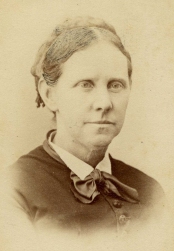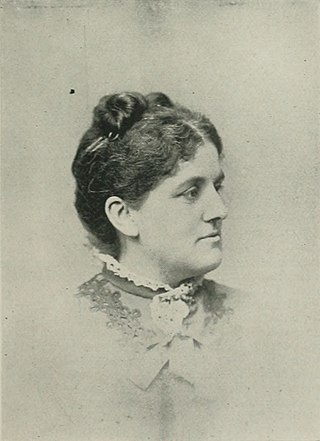Eva Channing | |
|---|---|
 | |
| Born | 1854 Boston |
| Died | 1930 North Carolina |
| Occupation | Suffragist |
| Parent(s) | |
Eva Channing (1854-1930) was a Boston area suffragist leader and writer.
Eva Channing | |
|---|---|
 | |
| Born | 1854 Boston |
| Died | 1930 North Carolina |
| Occupation | Suffragist |
| Parent(s) | |
Eva Channing (1854-1930) was a Boston area suffragist leader and writer.
Eva Channing was born in 1854 to parents William Francis Channing and Susan Elizabeth Burdick Channing. [1] Her mother was also active in the suffrage movement, and her grandfather, William Ellery Channing, was a well-known Unitarian minister. [1] Eva Channing attended Boston University as a member of the class of 1877. [1]
Channing served in a number of Boston area suffrage organizations, including the Massachusetts Woman Suffrage Association and the Massachusetts School Suffrage Association. [1] In addition, she wrote frequent contributions to the Women's Journal, advocating for women's rights in both Europe, particularly Germany, and the United States. [1]

Lucy Stone was an American orator, abolitionist and suffragist who was a vocal advocate for and organizer promoting rights for women. In 1847, Stone became the first woman from Massachusetts to earn a college degree. She spoke out for women's rights and against slavery. Stone was known for using her birth name after marriage, contrary to the custom of women taking their husband's surname.

Julia Ward Howe was an American author and poet, known for writing the "Battle Hymn of the Republic" and the original 1870 pacifist Mother's Day Proclamation. She was also an advocate for abolitionism and a social activist, particularly for women's suffrage.

Wendell Phillips was an American abolitionist, advocate for Native Americans, orator, and attorney.

Henry Browne Blackwell, was an American advocate for social and economic reform. He was one of the founders of the Republican Party and the American Woman Suffrage Association. He published Woman's Journal, starting in 1870 in Boston, Massachusetts, with Lucy Stone.

William Henry Channing was an American Unitarian clergyman, writer and philosopher.

Thomas Wentworth Higginson was an American Unitarian minister, author, abolitionist, politician, and soldier. He was active in abolitionism in the United States during the 1840s and 1850s, identifying himself with disunion and militant abolitionism. He was a member of the Secret Six who supported John Brown. During the Civil War, he served as colonel of the 1st South Carolina Volunteers, the first federally authorized black regiment, from 1862 to 1864. Following the war, he wrote about his experiences with African American soldiers and devoted much of the rest of his life to fighting for the rights of freed people, women, and other disfranchised peoples. He is also remembered as a mentor to poet Emily Dickinson.
Josephine St. Pierre Ruffin was a publisher, journalist, civil rights leader, suffragist, and editor of the Woman's Era, the first national newspaper published by and for African-American women.

Judith Winsor Smith was an American women's suffrage activist, social reformer, and abolitionist. She was involved in the suffrage movement until the Nineteenth Amendment was passed in 1920, when she voted for the first time at the age of 99. She was a founder and the first president of the Home Club of East Boston, one of the first women's clubs in Massachusetts.

Alice Stone Blackwell was an American feminist, suffragist, journalist, radical socialist, and human rights advocate.

Woman's Journal was an American women's rights periodical published from 1870 to 1931. It was founded in 1870 in Boston, Massachusetts, by Lucy Stone and her husband Henry Browne Blackwell as a weekly newspaper. In 1917 it was purchased by Carrie Chapman Catt's Leslie Woman Suffrage Commission and merged with The Woman Voter and National Suffrage News to become known as The Woman Citizen. It served as the official organ of the National American Woman Suffrage Association until 1920, when the organization was reformed as the League of Women Voters, and the Nineteenth Amendment to the United States Constitution was passed granting women the right to vote. Publication of Woman Citizen slowed from weekly, to bi-weekly, to monthly. In 1927, it was renamed The Woman's Journal. It ceased publication in June 1931.

Mary Kenney O'Sullivan, was an organizer in the early U.S. labor movement. She learned early the importance of unions from poor treatment received at her first job in dressmaking. Making a career in bookbinding, she joined the Ladies Federal Local Union Number 2703 and organized her own group from within, Woman's Bookbinding Union Number 1.
The National Women's Rights Convention was an annual series of meetings that increased the visibility of the early women's rights movement in the United States. First held in 1850 in Worcester, Massachusetts, the National Women's Rights Convention combined both female and male leadership and attracted a wide base of support including temperance advocates and abolitionists. Speeches were given on the subjects of equal wages, expanded education and career opportunities, women's property rights, marriage reform, and temperance. Chief among the concerns discussed at the convention was the passage of laws that would give women the right to vote.

Florence Hope Luscomb was an American architect and women's suffrage activist in Massachusetts. She was one of the first ten women graduated from the Massachusetts Institute of Technology. Her degrees were in architecture. Luscomb became a partner in an early woman-owned architecture firm before work in the field became scarce during World War I. She then dedicated herself fully to activism in the women's suffrage movement, becoming a prominent leader of Massachusetts suffragists.

Dr. Charlotte Johnson Baker was an American physician who was the first woman to practice medicine in San Diego, California. She practiced obstetrics and gynecology at St. Joseph's Hospital, where her husband, Fred Baker, MD, was a general practitioner. The Bakers were the first husband-and-wife physicians in San Diego.
The Massachusetts Woman Suffrage Association (MWSA) was an American organization devoted to women's suffrage in Massachusetts. It was active from 1870 to 1919.

Ellen Battelle Dietrick (1847–1895) was an American suffragist and author who was active in the movement's organizations in Kentucky and Massachusetts. She was a core member of the group that published The Woman's Bible in the 1890s.

Almira Hollander Pitman was an American suffragist and women's rights activist. Pitman was largely active in New England and Massachusetts suffrage organizations. She was also instrumental in working for women's suffrage in Hawaii. Pitman was also known for her writing.

Harriette R. Shattuck was an American author, parliamentarian, teacher of parliamentary law, and pioneer suffragist. Shattuck served as assistant clerk of the Massachusetts House of Representatives in 1872, being the first woman to hold such a position. She wrote several books, including The Story of Dante's Divine Comedy (1887), Our Mutual Friend: A Comedy in Four Acts, Dramatized from Charles Dickens (1880), The "national" Method (1880), Marriage, Its Dangers and Duties (1882), Little Folks East and West (1891), Woman's Manual of Parliamentary Law (1891), The Woman's Manuel of Parliamentary Law (1895), Shattuck's Advanced Rules for Large Assemblies (1898), Our Mutual Friend: A Comedy, in Four Acts (1909), and Shattuck's Parliamentary Answers, Alphabetically Arranged (1915).

Kate Gannett Wells was an American writer and social reformer, and a prominent member of the anti-suffragist movement in the United States. Wells served on the Massachusetts Board of Education for twenty-four years beginning in 1888 and was a vice president of the New England Women's Club. She also published several books, including the novel In the Clearings (1884) and the nonfiction work Campobello: An Historical Sketch.